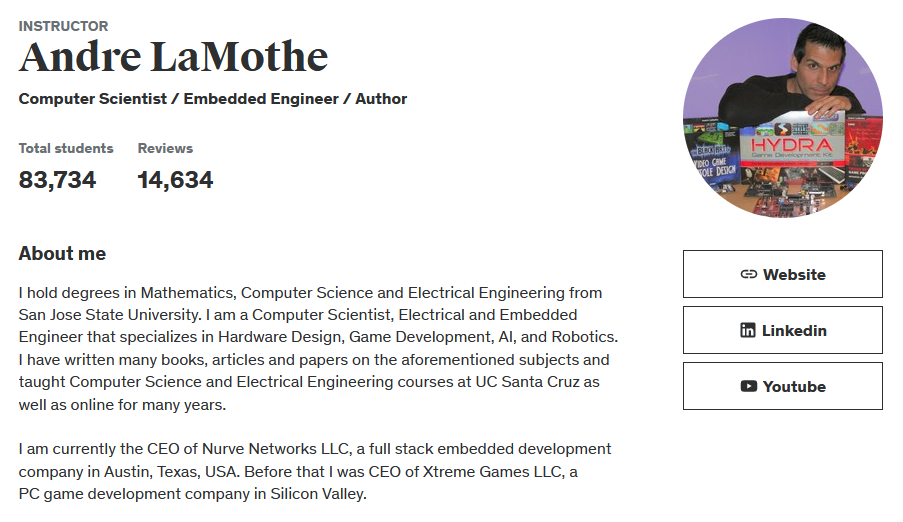Embarking on a journey through the complex world of electronics and PCB design can be daunting, yet Andre LaMothe’s “Crash Course Electronics and PCB Design” on Udemy turns this daunting task into an engaging adventure. From the electron’s dance to mastering Altium CircuitMaker and Labcenter Proteus, this course is a comprehensive guide that demystifies electronics, making it accessible to all.
Instructor Reputation: A Deep Dive into Andre LaMothe’s Expertise
Andre LaMothe stands as a colossus in the intersection of Computer Science, Electrical Engineering, and embedded systems development, wielding a towering reputation that’s not just built on his academic credentials but also on his practical experiences and contributions to the field. With degrees from San Jose State University—a solid foundation in Mathematics, Computer Science, and Electrical Engineering—LaMothe’s academic background is both broad and deep, providing him with a unique perspective that he generously shares with his students.

LaMothe’s professional journey is equally impressive, marked by significant stints as the CEO of Nurve Networks LLC and Xtreme Games LLC. His experience spans across hardware design, game development, AI, and robotics, areas in which he has not only practiced but also innovated. This wide-ranging expertise offers students a panoramic view of what electronics and PCB design entail in the real world, bridging the gap between theory and practice.
Beyond his professional achievements, LaMothe is a seasoned educator and author, having taught Computer Science and Electrical Engineering courses at UC Santa Cruz and authored numerous books, articles, and papers on his areas of expertise. His instructor rating of 4.7, based on over 14,634 reviews, attests to his ability to connect with students, demystify complex concepts, and inspire learners to explore and understand the intricacies of electronics and PCB design.
What sets LaMothe apart is not just his knowledge, but his passion for teaching and his commitment to making learning an enjoyable journey. His approach to education is rooted in the belief that everyone can master complex subjects if they’re taught in an engaging, relatable manner. This philosophy is evident in the way he designs his courses, making him not just an instructor but a mentor who guides his students through the complexities of electronics with ease and enthusiasm.
Course Structure: Crafting a Learning Journey
The “Crash Course Electronics and PCB Design” by Andre LaMothe is a masterclass in how to structure an educational journey that is comprehensive, coherent, and captivating. The course is ambitiously designed to cover a vast terrain of electronics and PCB design, starting from the very basics of atomic physics and electrons to advanced topics in analog and digital circuits, PCB design, and real-world product development. This broad scope ensures that students gain a holistic understanding of the subject matter, prepared to tackle real-world challenges upon completion.

What distinguishes this course’s structure is its incremental learning approach. Each lecture is carefully planned to build upon the last, ensuring that students solidify their understanding of previous concepts before moving on to more complex topics. This methodical approach is crucial in a field as complex as electronics, where each new concept often relies on a foundation of preceding knowledge.
LaMothe’s course is divided into manageable segments that cater to different learning objectives—from theoretical underpinnings in electrical engineering to practical skills in circuit design and PCB layout. This segmentation allows students to navigate through the course according to their individual learning pace and interests, making the massive amount of content feel less overwhelming.
The inclusion of hands-on projects is a cornerstone of the course structure. By designing and producing three complete products, students not only apply what they’ve learned in a practical setting but also experience the entire product development cycle from conception to production. This experiential learning aspect is invaluable, offering insights into real-world applications and challenges that electronics and PCB designers face.
Moreover, the course leverages a variety of teaching tools and methods to cater to different learning styles. From blackboard explanations and virtual simulations to high-definition video tutorials of actual circuit building, LaMothe ensures that every student, regardless of their preferred learning modality, can grasp the concepts being taught. This diverse instructional approach enriches the learning experience, making complex topics accessible and enjoyable to learn.
In summary, the structure of “Crash Course Electronics and PCB Design” is a testament to Andre LaMothe’s expertise as an educator. It reflects a deep understanding of how students learn, the challenges they face when tackling complex subjects, and the strategies that can help them succeed. This course is not just a collection of lectures; it’s a thoughtfully crafted educational journey designed to take students from curiosity to competence in electronics and PCB design.
Content Quality: A Closer Look at the Richness and Rigor
The content of “Crash Course Electronics and PCB Design” is nothing short of stellar, offering a blend of rigor, depth, and engaging presentation that sets a high benchmark for online courses in electronics and PCB design. Andre LaMothe’s methodical approach to distilling complex concepts into digestible and enjoyable lectures is evident throughout the course. This quality is crucial for a subject that encompasses a wide range of topics, from the fundamentals of atomic physics to the nuanced details of designing printed circuit boards (PCBs).

A standout feature of the course’s content is its hands-on approach to learning. LaMothe goes beyond theoretical explanations to demonstrate each concept through practical applications. This approach not only reinforces the learning but also provides students with a sense of how these concepts apply in real-world scenarios. The use of various CAD and design tools like Altium CircuitMaker and Labcenter Proteus is thoroughly covered, giving students invaluable experience with the software they will likely use in their careers.
Moreover, the course doesn’t just teach students how to use tools; it teaches them to understand the principles behind what they’re doing. This deep understanding is what enables students to go from following instructions to creating their own designs and innovations. The content is rich with examples of circuit analysis, PCB layout and routing, and even the use of MATLAB for more complex simulations. Each of these components is presented in high-definition video and audio, ensuring clarity and ease of following along.
What’s particularly impressive about the course’s content quality is the way LaMothe handles the most complex topics. Even subjects that traditionally require a lot of mathematical prowess are made accessible through clear explanations and multiple approaches to solving problems. This accessibility is a testament to the course’s well-thought-out content structure and LaMothe’s skill as an educator.
Overall Course Rating: 9.5/10
Considering the comprehensive scope, the depth of knowledge imparted, the quality of teaching, and the practical skills gained, “Crash Course Electronics and PCB Design” earns a solid 9.5 out of 10.

Strengths:
- Comprehensive Coverage: The course covers an impressive breadth of topics, providing students with a solid foundation in both the theoretical and practical aspects of electronics and PCB design.
- High-Quality Presentation: The use of high-definition video and audio enhances the learning experience, making complex concepts more accessible.
- Practical Application: The hands-on projects that involve designing, building, and producing PCBs offer invaluable real-world experience.
- Expert Instructor: Andre LaMothe’s expertise and engaging teaching style not only make learning enjoyable but also deeply informative.
Areas for Improvement:
- Hardware Requirements: The necessity for a modern Windows PC and specific tools might be a barrier for some students, although this is somewhat inherent to the nature of the course.
- Pace: Given its university-level depth and the volume of material covered, some students might find the pace challenging. However, this is also a strength for those seeking a comprehensive understanding.
In conclusion, this stands out as an exceptional course that successfully bridges the gap between theoretical knowledge and practical application in the field of electronics and PCB design. It’s a course that doesn’t just aim to educate but to inspire and empower students to delve deeper into the world of electronics. Whether you’re a beginner eager to learn about electronics from the ground up or someone with some experience aiming to solidify and expand your knowledge, this course is a valuable investment in your education and future in the field.



